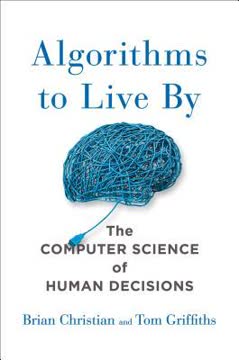Key Takeaways
1. Human behavior follows predictable patterns, challenging notions of randomness
"Despite the facts of my first story, this book is ultimately neither about Hasan nor the Department of Homeland Security. My goal instead is to address what is normal and what is unique when it comes to human activity."
Patterns in chaos: Human behavior, often perceived as random and unpredictable, actually follows discernible patterns. Research across various fields, from physics to sociology, reveals that our actions and movements are far more regular and foreseeable than previously thought. This challenges our traditional notions of free will and spontaneity.
Predictability in diversity: While individuals may appear unique in their daily routines, large-scale studies show remarkable similarities in human behavior patterns across populations. For example:
- Mobile phone data reveals that most people's movements are confined to a few key locations
- Email and communication patterns follow similar bursty rhythms across diverse populations
- Even seemingly random activities like web browsing exhibit predictable patterns
These findings suggest that underlying laws govern human behavior, much like physical laws govern the motion of particles or planets.
2. Bursts of activity characterize human dynamics across various domains
"No matter what human activity we examined, the same bursty pattern greeted us: long periods of rest followed by short periods of intense activity, like the pleasing sound of violins interrupted by the violent roar of drums in a Beethoven masterpiece."
Universal burstiness: Bursts of activity, characterized by periods of intense action followed by relative inactivity, are a fundamental feature of human behavior. This pattern is observed across diverse domains:
- Communication: Email, phone calls, and messaging exhibit bursty patterns
- Mobility: Human travel patterns show bursts of movement interspersed with stationary periods
- Productivity: Work and creative output often come in bursts rather than steady streams
- Web activity: Browsing and content creation follow bursty rhythms
Implications of burstiness: Understanding the bursty nature of human activity has significant implications:
- Resource allocation: Designing systems to handle bursts of activity rather than steady loads
- Predicting behavior: Anticipating periods of high and low activity in various contexts
- Understanding social dynamics: Explaining phenomena like information spread and trend adoption
3. Power laws govern many aspects of human behavior and social phenomena
"The essence of a power-law distribution is that it naturally predicts such rare events, telling us that we will always have a few data points that grossly deviate from the average."
Ubiquity of power laws: Power laws, mathematical relationships where one quantity varies as a power of another, are surprisingly common in human and social systems:
- Wealth distribution: A small number of individuals hold a disproportionate amount of wealth
- City sizes: A few megacities coexist with many smaller towns and villages
- Word frequency: A small number of words are used very frequently, while most are rare
- War casualties: Most conflicts have few casualties, but a few are extremely deadly
Implications of power laws:
- Expect outliers: Extreme events or individuals are natural, not anomalies
- Scale-free behavior: Similar patterns appear at different scales of observation
- Predictability in variation: While individual events may be unpredictable, the overall distribution follows a consistent pattern
Understanding power laws helps explain why "black swan" events occur more frequently than expected in many domains, from finance to natural disasters.
4. Historical events can be understood through the lens of human dynamics
"Forget dice rolling or boxes of chocolates as metaphors for life. Think of yourself as a dreaming robot on autopilot, and you'll be much closer to the truth."
History as patterns: Historical events, often viewed as unique and unpredictable, can be understood as manifestations of underlying patterns in human behavior. The book uses the story of György Székely and the 1514 Hungarian peasant revolt to illustrate this concept:
- Individual actions (György's rise to leadership) reflect broader social dynamics
- The spread of the revolt follows patterns similar to modern information diffusion
- Power struggles and alliances mirror network dynamics observed in other complex systems
Lessons from the past: Analyzing historical events through the lens of human dynamics offers insights:
- Predictability in chaos: Even seemingly chaotic events follow discernible patterns
- Universal principles: Similar dynamics govern events across different time periods and cultures
- Learning from history: Understanding these patterns can inform predictions and decision-making in modern contexts
5. Prioritization drives the bursty nature of human activities
"If we want to treat it with respect, we need to set priorities. Once we do that, power laws and burstiness become unavoidable."
Priority queues: The bursty nature of human activities can be explained by how we prioritize tasks. This process creates a natural hierarchy of importance and urgency:
- High-priority tasks are executed quickly, creating bursts of activity
- Low-priority tasks may be postponed indefinitely, leading to long periods of inactivity
- The constant influx of new tasks and shifting priorities creates a dynamic system
Modeling human behavior: Understanding prioritization helps model and predict human behavior:
- Task execution patterns can be simulated using priority queue models
- These models accurately reproduce observed bursty patterns in various activities
- Insights from priority models can be applied to optimize workflows and systems
The priority model explains why seemingly unrelated activities, from email communication to mobility patterns, exhibit similar bursty characteristics.
6. Modern technology enables unprecedented tracking and prediction of human behavior
"Today just about everything we do leaves digital breadcrumbs in some database."
Digital footprints: Advanced technology and ubiquitous data collection have created an unprecedented ability to track and analyze human behavior:
- Mobile phones track location and communication patterns
- Online activities reveal preferences, interests, and social connections
- Financial transactions provide insights into spending habits and economic behavior
- IoT devices capture details of daily routines and habits
Big data insights: This wealth of data enables powerful predictions and insights:
- Predictive algorithms anticipate individual and collective behavior
- Pattern recognition reveals hidden regularities in human activities
- Machine learning models can make increasingly accurate forecasts about human dynamics
The ability to track and predict behavior at this scale raises both exciting possibilities and significant ethical concerns.
7. The tension between predictability and privacy raises ethical concerns
"Hasan has a refreshing answer to this question... Give it up, and it becomes worthless. 'It is the secrecy applied to the information that makes it valuable,' he says."
Privacy paradox: The increasing predictability of human behavior creates a tension with traditional notions of privacy:
- More data leads to better predictions but also increased surveillance
- Individual privacy may conflict with societal benefits of behavioral insights
- The line between useful data and invasive monitoring is often blurry
Ethical considerations:
- Data ownership: Who controls and profits from personal behavioral data?
- Consent and transparency: How informed are individuals about data collection and use?
- Discrimination: Could predictive models reinforce biases or lead to unfair treatment?
- Security: How can sensitive behavioral data be protected from misuse?
Balancing the benefits of behavioral prediction with privacy concerns is a key challenge for society in the age of big data.
8. Understanding human dynamics has far-reaching implications for society
"The predictive power of human dynamics is far more than credit scores and number crunching. It is a journey driven by the hope that one day it will make our planet a better home."
Transformative potential: Insights from human dynamics research can revolutionize various aspects of society:
- Urban planning: Designing cities and transportation systems based on actual movement patterns
- Public health: Predicting and mitigating disease spread through understanding human interactions
- Resource allocation: Optimizing services and infrastructure based on usage patterns
- Economic forecasting: Improving models of market behavior and consumer trends
- Conflict prevention: Identifying early warning signs of social unrest or violence
Challenges and opportunities:
- Interdisciplinary collaboration: Combining insights from physics, sociology, computer science, and other fields
- Ethical framework: Developing guidelines for responsible use of human dynamics insights
- Education: Promoting understanding of these concepts to empower individuals and policymakers
- Innovation: Creating new technologies and services based on predictive models of human behavior
Understanding human dynamics offers the potential to create more efficient, sustainable, and harmonious societies, but realizing this potential requires careful consideration of ethical and social implications.
Last updated:
FAQ
1. What is Bursts: The Hidden Pattern Behind Everything We Do by Albert-László Barabási about?
- Exploring hidden patterns: The book reveals that human behavior, while seemingly random, actually follows predictable patterns governed by scientific laws.
- Interdisciplinary investigation: Barabási draws from physics, computer science, sociology, and history to uncover the rhythms behind our actions, from daily routines to major historical events.
- Digital data revolution: The rise of digital technologies and big data enables unprecedented analysis and prediction of human behavior at scale.
- Burstiness as a core theme: The concept of "bursts"—periods of intense activity followed by inactivity—serves as a unifying thread throughout the book.
2. Why should I read Bursts by Albert-László Barabási?
- Understanding human behavior: The book provides a scientific framework for why our actions, though seemingly spontaneous, are often reproducible and predictable.
- Relevance to modern life: It explains how digital footprints and big data are transforming our understanding of mobility, communication, and social interactions.
- Engaging storytelling: Barabási connects abstract scientific concepts to real-world events and personal stories, making complex ideas accessible and compelling.
- Implications for society: The book raises important questions about privacy, surveillance, and the ethical use of predictive technologies.
3. What are the key takeaways from Bursts: The Hidden Pattern Behind Everything We Do?
- Human behavior is bursty and predictable: Despite apparent randomness, our actions follow bursty patterns driven by priorities, leading to routines with occasional surprises.
- Universal laws govern activity: Large-scale data reveals that many aspects of human dynamics, from communication to mobility, follow power-law distributions and are highly predictable.
- Ethical and societal challenges: The ability to predict behavior raises concerns about privacy, surveillance, and the societal impact of predictive models.
- Interdisciplinary insights: The book demonstrates the value of combining physics, data science, and history to understand ourselves and our societies.
4. What is "burstiness" and how does Albert-László Barabási define it in Bursts?
- Definition of burstiness: Burstiness refers to short periods of intense activity followed by long stretches of inactivity, a pattern seen in many human behaviors.
- Contrast with randomness: Unlike traditional models that assume uniform randomness, bursty patterns are uneven and clustered.
- Examples in daily life: Emailing, phone calls, and even historical events like wars exhibit bursty timing rather than steady, regular intervals.
- Rooted in prioritization: Barabási attributes burstiness to how humans prioritize tasks, focusing on urgent matters and letting others wait.
5. How does the priority queuing model explain bursty human activity in Bursts?
- Task prioritization mechanism: Humans maintain lists of tasks with assigned priorities, typically addressing the most urgent first.
- Power-law waiting times: This approach leads to most tasks being handled quickly, while some low-priority tasks experience long delays, resulting in power-law distributions.
- Modeling burstiness: The priority queuing model mathematically reproduces the observed bursty patterns in communication and activity.
- Efficiency vs. fairness: The model highlights a trade-off—prioritizing tasks increases efficiency but can lead to unfairly long waits for less urgent matters.
6. What are Lévy flights and how do they relate to human mobility in Bursts?
- Definition of Lévy flights: Lévy flights are random walks with many short steps and occasional long jumps, following a power-law distribution of step sizes.
- Application to humans and animals: Studies show that both animals (like albatrosses) and, to some extent, humans exhibit Lévy flight patterns in their movements.
- Dollar bill tracking: The movement of dollar bills, as tracked by WheresGeorge.com, initially suggested humans move in Lévy flight patterns.
- Mobility paradox: Mobile phone data reveals most people have stable, limited movement areas, and the apparent Lévy pattern arises from population heterogeneity—some outliers travel far, but most stay local.
7. How does Bursts use the story of Hasan Elahi to illustrate its scientific themes?
- Surveillance and predictability: Elahi’s experience with FBI surveillance after 9/11 highlights how human actions can be tracked and analyzed for predictability.
- Self-surveillance as data: By publicly sharing his movements and activities, Elahi created a unique dataset, flipping the concept of surveillance on its head.
- Outlier significance: His unpredictable mobility challenged surveillance algorithms, illustrating the limits of predictive models and the importance of outliers.
- Privacy paradox: Elahi’s case raises questions about privacy, control, and the implications of living in a data-rich world.
8. What does Bursts reveal about the predictability of human behavior using digital data?
- High predictability found: Analysis of mobile phone data shows that human movements are about 93% predictable on average, with most people following regular routines.
- Entropy as a measure: The book uses entropy to quantify unpredictability, showing that even those with high entropy (more randomness) are still largely predictable.
- Limits to prediction: There are fundamental limits—no algorithm can perfectly forecast human behavior due to inherent burstiness and priority-driven actions.
- Routine vs. surprise: Most behavior is routine, but transitions between activities remain difficult to predict.
9. How does Bursts connect historical events like the 1514 Hungarian Crusade to its scientific concepts?
- Historical case study: The book uses the 1514 peasant uprising led by György Dózsa Székely to illustrate bursts of intense activity and their societal impact.
- Patterns in history: Even complex social and political events can be analyzed for bursty patterns and power-law distributions in conflict sizes.
- Prophecy vs. prediction: The narrative contrasts historical prophecies with modern scientific forecasting, exploring the limits of predicting human events.
- Legacy and interpretation: Székely’s story serves as a bridge between historical bursts and modern scientific understanding of human dynamics.
10. What role do power laws play in the analysis of human activity in Bursts?
- Power-law distributions: Many human phenomena, from email response times to wealth distribution, follow power-law patterns where a few events are very large and most are small.
- Scale-free behavior: Power laws indicate that there is no typical scale for events—extreme occurrences are natural and expected.
- Modeling implications: Recognizing power laws allows for better models of social systems, disease spread, and information flow.
- Challenging traditional models: These findings challenge the adequacy of Gaussian and Poisson models in explaining real-world human behavior.
11. How does Bursts address privacy and surveillance in the age of big data?
- LifeLinear concept: Barabási imagines a system that continuously tracks individuals using video, web data, and behavioral models, exemplifying potential privacy loss.
- Community vs. individual privacy: The book discusses how traditional societies had less need for privacy due to interdependence, contrasting with modern Western expectations.
- Trade-offs and risks: The benefits of data collection for prediction and security are weighed against the risks to individual privacy and freedom.
- Case studies: Real-world examples, like Hasan Elahi’s self-surveillance, illustrate the complexities and paradoxes of privacy in a data-rich society.
12. What are the limitations of traditional random (Poisson) models in explaining human behavior, according to Bursts by Albert-László Barabási?
- Mismatch with empirical data: Poisson models assume uniform randomness and exponential waiting times, but real human activity shows power-law distributions and burstiness.
- Invisible slowing forces: Observed phenomena, such as slower-than-expected spread of dollar bills and longer news item lifetimes, suggest additional mechanisms at play.
- Need for new paradigms: The book argues for models that incorporate priority, memory, and social factors to better capture the complexity of human actions.
- Broader implications: Moving beyond Poisson models enables more accurate forecasting and understanding of social, economic, and health-related phenomena.
Review Summary
Bursts explores human behavior patterns, arguing that activities occur in bursts rather than randomly. While some readers found the concept intriguing, many felt the book's structure was disjointed, with extensive Hungarian history distracting from the main thesis. Barabási's writing style received praise, but the scientific content was criticized as lacking depth. The book's attempts to link predictability, privacy, and historical events were seen as ambitious but often unsuccessful. Overall, reviewers had mixed feelings, appreciating the author's creativity but finding the execution flawed.
Similar Books










Download PDF
Download EPUB
.epub digital book format is ideal for reading ebooks on phones, tablets, and e-readers.






